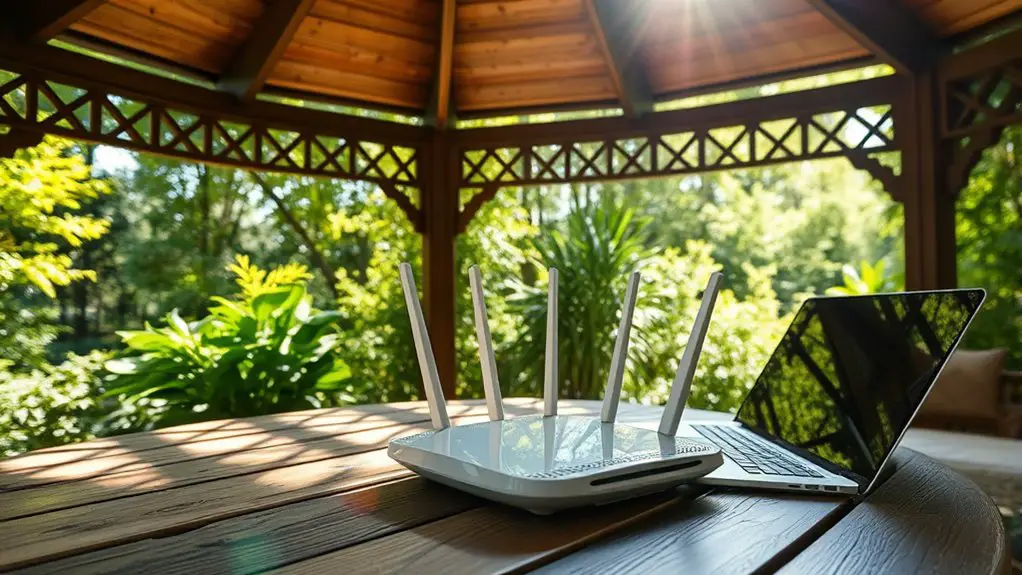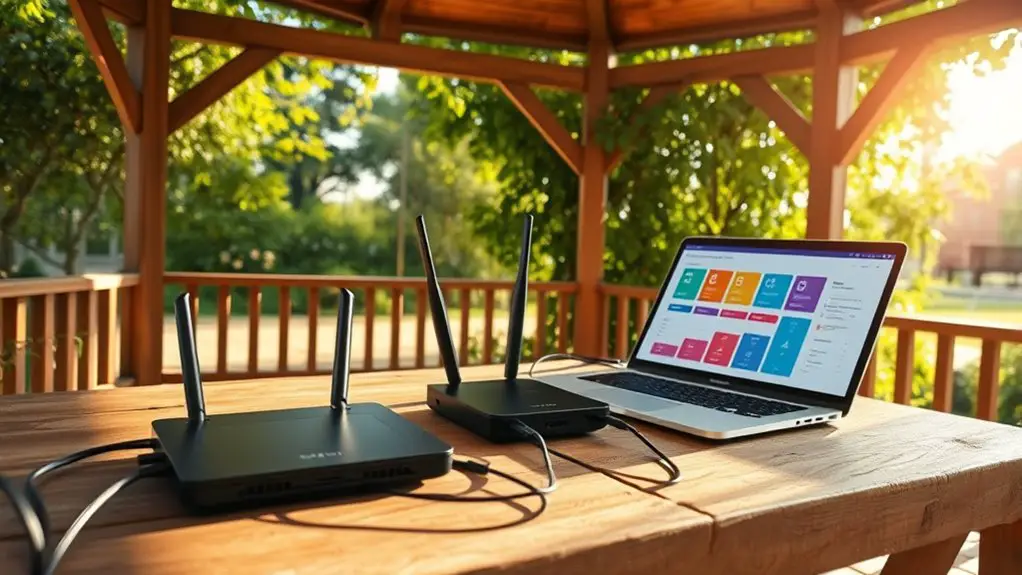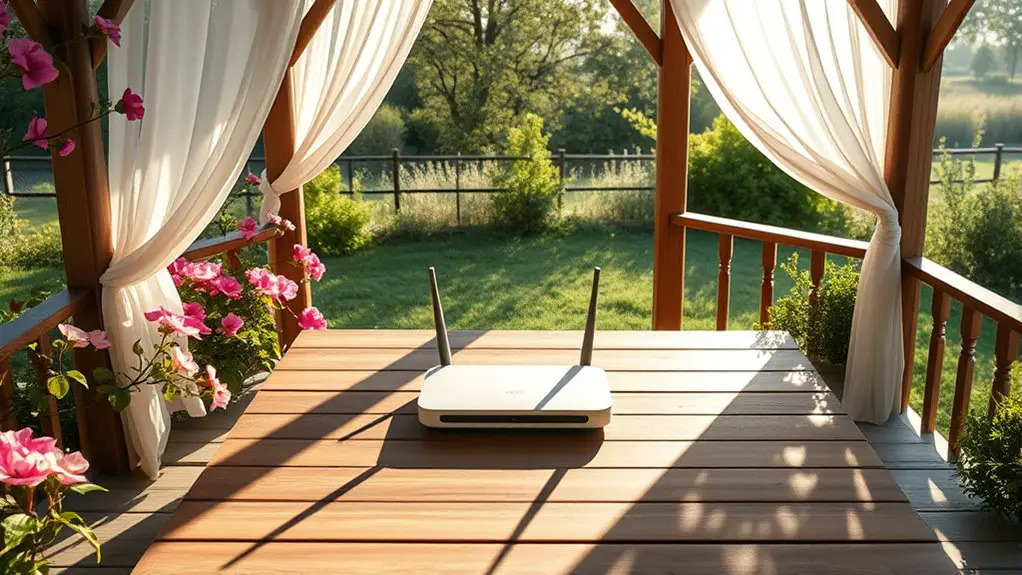Installing a Wi-Fi router in your gazebo enhances your remote work setup. First, assess the space for obstructions and power access. Choose a dual-band router that meets your speed needs. Position it centrally, ideally 5 to 7 feet high, to maximize signal strength. Consider a Wi-Fi extender if distance is an issue. Weatherproof your setup with outdoor-rated materials and test the connection strength using an analyzer tool. If you’d like more tips, there’s plenty more to explore.
Assessing Your Gazebo Space for Wi-Fi Installation

Before installing a Wi-Fi router in your gazebo, you should first evaluate the available space and its suitability for the equipment. Start by examining the gazebo layout; make certain there’s adequate room for the router and any additional hardware. Consider the height and location of the router, as these factors greatly influence signal strength and coverage.
Next, identify any potential obstructions—walls, furniture, or foliage—that could interfere with the Wi-Fi signal. Confirm the gazebo’s materials, like wood or metal, won’t impede connectivity.
If your space permits, position the router centrally to maximize coverage throughout the area. Additionally, verify there’s access to power outlets for the router and any necessary accessories. By meticulously evaluating space and layout, you’ll create an ideal environment for seamless Wi-Fi connection, allowing you to enjoy your remote work in the tranquility of your gazebo. Furthermore, ensure that the gazebo is placed in a location with sun and shade exposure to optimize the equipment’s performance and prevent overheating.
Choosing the Right Wi-Fi Router
When choosing a Wi-Fi router for your gazebo, consider both the range and speed to guarantee reliable connectivity. A router with a wider range can cover more area, while higher speeds are essential for activities like streaming and gaming. Assess your specific needs to select a router that balances these performance factors effectively.
Router Range Considerations
Choosing the right Wi-Fi router is vital for guaranteeing adequate coverage in your gazebo, especially since outdoor environments can present unique challenges. You’ll want to assess the router’s range and performance capabilities. Effective router placement is significant; locate the router as close to the gazebo as possible to minimize distance-related signal loss. Additionally, be aware of potential signal interference from trees, walls, and other structures. Using a dual-band router can help mitigate interference and provide better coverage. If your gazebo is particularly far from your main router, think about using a Wi-Fi extender or mesh system to enhance your signal. Ultimately, ideal router selection and placement will guarantee you stay connected while enjoying your outdoor workspace.
Speed and Performance Factors
While it’s vital to have adequate coverage in your gazebo, the speed and performance of your Wi-Fi connection are equally important for a seamless online experience. To achieve this, choose a router with strong signal strength and minimal signal interference. Look for dual-band or tri-band routers that can manage multiple devices efficiently. Bandwidth management features are significant, allowing you to prioritize tasks like video conferencing or streaming without lag. Additionally, confirm the router supports the latest Wi-Fi standards, like Wi-Fi 6, for peak speed. Positioning your router strategically within the gazebo can also reduce obstacles that may disrupt the signal. By considering these factors, you can enhance your remote work experience in your outdoor workspace.
Understanding Your Internet Service Plan

To effectively set up a Wi-Fi router in your gazebo, you need to understand your internet service plan. Consider your internet speed requirements and how much data you’ll use to guarantee smooth connectivity. Additionally, explore service provider options to find the best fit for your needs.
Internet Speed Requirements
Understanding your internet service plan is crucial for maximizing Wi-Fi performance in your gazebo, especially since different activities demand varying speeds. For basic tasks like browsing or emailing, speeds of 1-5 Mbps might suffice. However, if you’re streaming video or participating in video conferences, aim for ideal speeds of at least 25 Mbps. It’s important to assess your bandwidth requirements based on the number of devices connected and the types of activities you’ll perform. If multiple users are streaming or gaming simultaneously, your plan should support higher speeds to avoid lag. By choosing the right internet plan, you’ll guarantee a seamless remote work experience in your gazebo, providing you the freedom to work from anywhere.
Data Usage Considerations
When considering internet service for your gazebo, data usage is a key factor that can impact your experience. You’ll want to understand the data limits of your service plan to avoid unexpected overage charges. If you’re streaming video, downloading large files, or participating in video calls, your data consumption can increase considerably. Usage monitoring tools can help you track your consumption in real time, allowing you to adjust your habits as needed. Consider opting for an unlimited data plan if you plan to work extensively in your gazebo. This way, you can enjoy the freedom of remote work without the constant worry of exceeding your data limits, ensuring a smooth and uninterrupted experience.
Service Provider Options
Choosing the right internet service provider (ISP) is essential for guaranteeing a reliable connection in your gazebo. When you’re working remotely, you want to feel liberated, not frustrated by poor connectivity. To make an informed decision, consider these key service plan features:
- Speed: Higher speeds can support multiple devices without lag.
- Data Caps: Unlimited plans offer the freedom to stream and download without worry.
- Contract Terms: Flexible contracts provide you with the freedom to switch if needed.
- Customer Support: Responsive support guarantees you can resolve issues quickly.
Planning the Router’s Location in the Gazebo

To guarantee ideal Wi-Fi coverage in your gazebo, you’ll need to carefully consider the router’s location. Start by evaluating the furniture layout; placing the router in a central position guarantees a more even distribution of the signal. Avoid areas obstructed by large items or walls that could weaken connectivity.
Router height is vital, too. Ideally, mount your router high on a wall or shelf to maximize coverage area and minimize interference. A height of around 5 to 7 feet is often best. This elevation helps the signal propagate more effectively, especially if you have furniture that might otherwise block the signal path.
Consider the gazebo’s design and any nearby obstacles, like trees or structures, that could impede the signal. Taking these factors into account will set you up for success, allowing you to work freely and efficiently in your serene outdoor space. Additionally, properly securing your gazebo from wind damage will help maintain a stable environment for your Wi-Fi setup.
Extending Your Wi-Fi Range With a Signal Booster
To extend your Wi-Fi range effectively, you’ll need to choose the right signal booster for your gazebo setup. Consider factors like compatibility with your existing router and the coverage area you want to enhance. Once you’ve selected a booster, follow specific installation tips to maximize your network’s performance.
Choosing the Right Booster
When it comes to extending your Wi-Fi range, selecting the right signal booster can make all the difference. To guarantee ideal outdoor connectivity and robust signal strength, consider these key factors:
- Compatibility: Make sure the booster works with your existing router.
- Range: Look for a model that covers the distance you need, especially for your gazebo.
- Frequency Bands: Choose dual-band boosters for better performance on both 2.4GHz and 5GHz bands.
- Installation Ease: Opt for a user-friendly booster that aligns with your desire for a hassle-free setup.
Installation Tips and Tricks
After selecting the right signal booster, it’s time to focus on proper installation to maximize your Wi-Fi range. Here are some tips to guarantee effective installation:
| Tip | Description |
|---|---|
| Location | Place the booster halfway between the router and your gazebo. |
| Antenna Orientation | Adjust antennas vertically for ideal coverage. |
| Power Source | Make sure it’s near an outlet for continuous power. |
| Cable Management | Use clips to secure cables, preventing trips and tangles. |
| Device Security | Lock the booster in a secure area to prevent theft. |
Ensuring Power Supply for Your Router
While you might be enthusiastic to set up your Wi-Fi router in the gazebo, ensuring a reliable power supply is essential for ideal performance. A consistent power source helps maintain connectivity, allowing you to work freely without interruptions. Here are some key considerations for your power setup:
- Choose the right power source: Opt for an outdoor-rated extension cord or install a dedicated circuit if possible.
- Ensure cable management: Use cable clips or conduits to secure and tidy up any loose wires, preventing tripping hazards.
- Consider battery backup: A UPS can keep your router running during brief outages, safeguarding your work.
- Check local regulations: Always follow safety codes for outdoor electrical installations to avoid hazards. Additionally, ensure proper grounding of all electrical equipment to prevent shocks and enhance safety.
Weatherproofing Your Wi-Fi Equipment
To guarantee your Wi-Fi equipment remains functional in varying weather conditions, it’s crucial to implement effective weatherproofing measures. Start by selecting weatherproof materials for your router and accessories. Look for devices rated for outdoor use, as they’re designed to withstand moisture, dust, and extreme temperatures.
Next, consider using protective enclosures. These can safeguard your equipment from rain, wind, and UV exposure. Confirm the enclosure is well-ventilated to prevent overheating while still providing robust protection. Using sealants around any openings will help further enhance moisture resistance.
Additionally, elevate your router off the ground to avoid water pooling during heavy rain. Positioning it under the gazebo roof can also shield it from direct exposure. Regularly check for wear and tear, replacing any damaged materials promptly to maintain peak performance. With these steps, you’ll guarantee a reliable Wi-Fi connection that supports your remote work needs, no matter the weather. Furthermore, ensuring regular inspections of your equipment will help detect potential issues early, allowing for timely maintenance and repairs.
Setting Up the Router and Configuring Settings
Once you’ve weatherproofed your Wi-Fi equipment, the next step is setting up the router and configuring its settings for peak performance. This guarantees you’ll enjoy seamless connectivity while working in your gazebo. Follow these steps:
- Connect the Router: Plug in your router and connect it to your internet source.
- Access Settings: Use a web browser to access the router’s IP address, usually found in the manual.
- Update Firmware: Check for firmware updates; staying current is vital for security and performance.
- Enhance Router Security: Change the default password and enable WPA3 encryption to protect your network.
Testing Your Wi-Fi Connection in the Gazebo
How can you confirm your Wi-Fi connection is reliable in the gazebo? Start by testing your signal strength at various locations within the space. Use a Wi-Fi analyzer app on your smartphone or laptop to measure the signal quality. Look for at least a 70% signal strength for peak performance.
Next, conduct a speed test while in the gazebo to assess connection stability. This will help you determine if the download and upload speeds meet your remote work needs. If you notice fluctuations or slow speeds, consider repositioning the router or adding a Wi-Fi extender to boost the signal.
Finally, check your connection during peak usage times to verify it remains stable. Consistent connectivity is essential for a productive workspace. Once you’ve confirmed solid signal strength and stability, you can confidently enjoy the freedom of working from your gazebo.
Tips for Maintaining a Productive Outdoor Workspace
While working outdoors can enhance creativity and well-being, maintaining a productive workspace in your gazebo requires careful planning and organization. Here are some tips to guarantee you stay focused and comfortable:
- Choose Ergonomic Furniture: Invest in a quality chair and desk that support your posture and keep you comfortable for long hours.
- Incorporate Outdoor Decor: Use plants and art to create a visually appealing environment that inspires creativity.
- Control Your Environment: Set up shade and use fans or heaters to regulate temperature, assuring a pleasant working atmosphere.
- Limit Distractions: Keep your workspace tidy and designate specific work hours to fend off interruptions from nature or household activities.
- Consider Proper Weatherproofing: Ensuring your gazebo is well-insulated and weatherproofing essential will help protect your office equipment from the elements.
Frequently Asked Questions
Can I Use a Mobile Hotspot Instead of a Wi-Fi Router?
Yes, you can use a mobile hotspot instead of a Wi-Fi router. Mobile hotspots offer portability and flexibility, but they have limitations like data caps and potential connectivity issues in remote areas. Consider your needs carefully.
What Happens During Heavy Rain or Storms?
During heavy rain or storms, your setup’s at risk. By using weatherproofing techniques and implementing storm preparedness, you can guarantee your equipment stays functional, allowing you the freedom to work uninterrupted, rain or shine.
How Do I Secure My Wi-Fi Network From Unauthorized Access?
To secure your Wi-Fi network, implement strong network encryption like WPA3, disable guest access if unnecessary, and regularly update your router’s firmware. These steps will greatly reduce the risk of unauthorized users accessing your network.
Can I Use My Existing Router for the Gazebo Installation?
You can’t have your cake and eat it too, but you can use your existing router if it’s compatible. Check router compatibility, and follow installation tips for ideal performance in your gazebo setup.
How Far Can My Wi-Fi Signal Reach Outside the Gazebo?
Your Wi-Fi range typically extends 100-300 feet outdoors, depending on obstacles and signal strength. Factors like walls, trees, and interference can reduce this distance, so positioning your router for ideal coverage is essential for maximum effectiveness.

